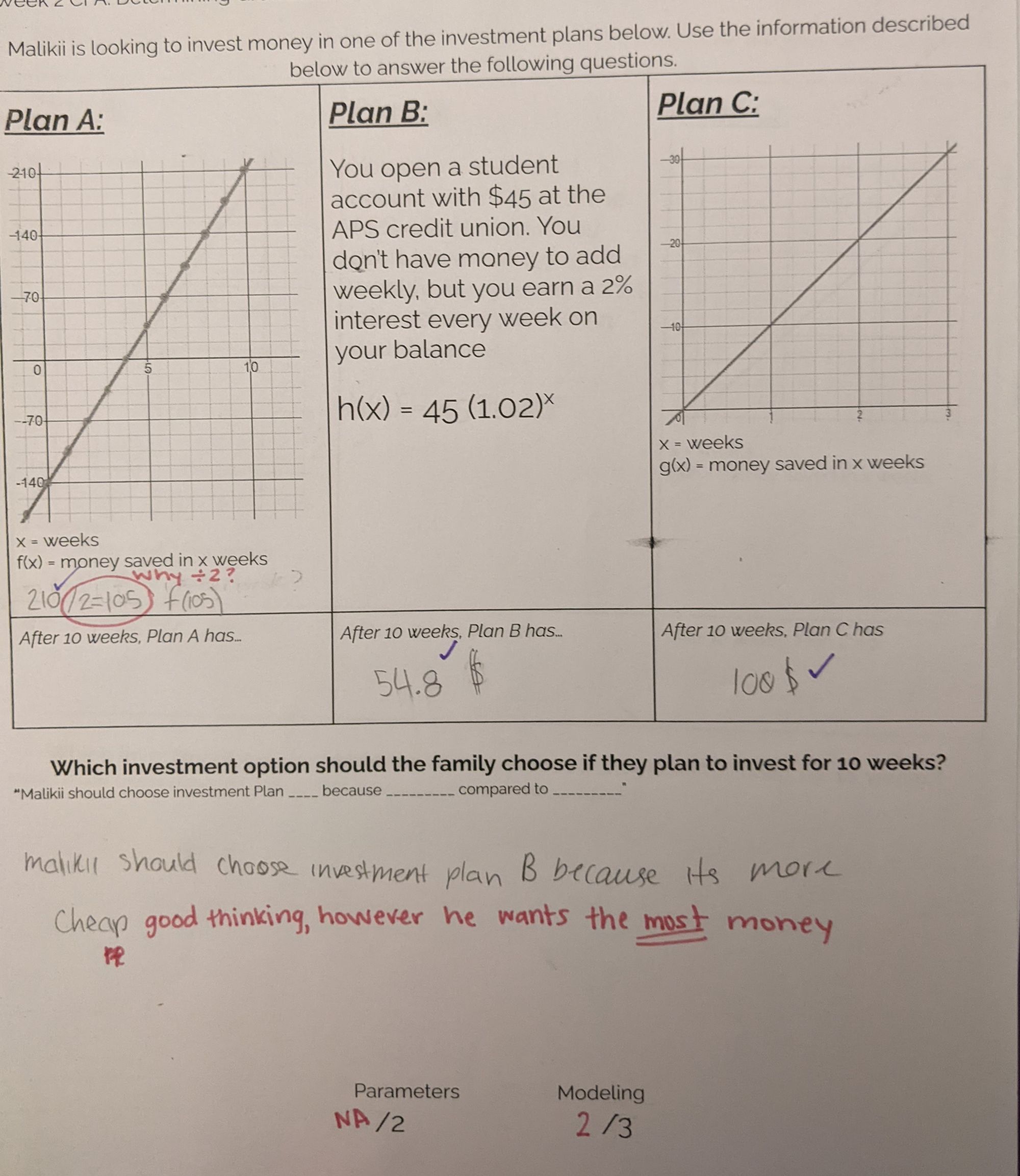For the linear and exponential functions unit, I recently gave a short CFA where students were asked to help a student select the best investment plan when the student was planning to invest for ten weeks. Below is the assessment with one student's work.

There were two grades for this assessment. The first grade was for linear and exponential parameters. We wanted to see if students could identify the growth rate and initial values of linear functions from graphs and use the parameters in linear equations. The students above did not create any equations and we couldn't see them finding the parameters from the graphs, so we left the grade as N/A for now. Students will get more opportunities to show us this learning later in the unit. The focus for this quiz was getting students used to comparing answers in the context of a problem, modeling a context, and finding specific points of interest from a function. We did not give this student a zero for this section, because the student did not incorrectly select parameters, or incorrectly use parameters, the student just did not use parameters, and because we did not explicitly ask students to use parameters on this quiz, it would be unfair to give zeros if students were successful in finding answers without finding and using growth rate and initial value. Many students in the class got an N/A for this section, which shows that students are not yet comfortable with finding growth rate and initial values from graphs, and that we will have to provide more opportunities to practice that skill in the coming weeks.
The second grade for this assessment was for modeling. This grade was based on whether the students could figure out how much money Malikii would have in 10 weeks for each of the investment plans and explain which investment plan would be the best in context. The scoring is based off of the proficiency scale created from the modeling standards for this unit. Below is the modeling proficiency scale.

Students could achieve a score of 3, or mastering, on this quiz. The student above achieved a score of 2, approaching. The student successfully used the equation in Plan B to find a point of interest in the function (week 10). They also successfully extrapolated the graph in Plan C to get the investment amount at week 10, showing that they understand that every point on a graph is a solution to the function. The student also successfully explained why they would select Plan B using the context of the problem, showing that they understood how the math related to a real world scenario and could draw conclusions based off of their work. We did not count them off for selecting the plan with the least money due to that being a misunderstanding of what investment plans are, and not a misunderstanding of the math or context. In the future a quick description of investment plans for this quiz might help students and would be a good scaffold for English Language Learners as well. The student did not achieve a 3, mastering, because they did not create any equations representing the investment plans. The next quiz will explicitly ask for equations and this student will be able to show their learning for constructing equations at that point and achieve a 3, which will then supersede this quiz's grade. At this point I know that this student can understand the context of a problem, use math to draw conclusions about the problem's context, and understands how to find points of interest in equations.
The feedback I provided was to get a better understanding of why they divided 120 by 2 for Plan A. Looking at their work I was uncertain on whether they have a misconception on how to read the graph, or if dividing by 2 was simply a mistake caused by rushing or nerves during the quiz. I discussed the quiz with the student and they explained that the dividing by two was because they were confused what to do when the initial value was negative since you can't start an investment with negative money. This showed me that I need to have more examples of functions that go into negative values in future classes, and I also bumped this student's grade up to a 1 for parameters since they correctly identified the initial value from the graph. My other feedback was just to clarify what investment plans are and what we are looking for when comparing them.
Based off of what I saw on this quiz, I will have to include more functions that involve negative numbers, include explanations for contexts of problem, so that students know the background of the problems, and be more intentional when asking for mathematical ideas like using parameters.